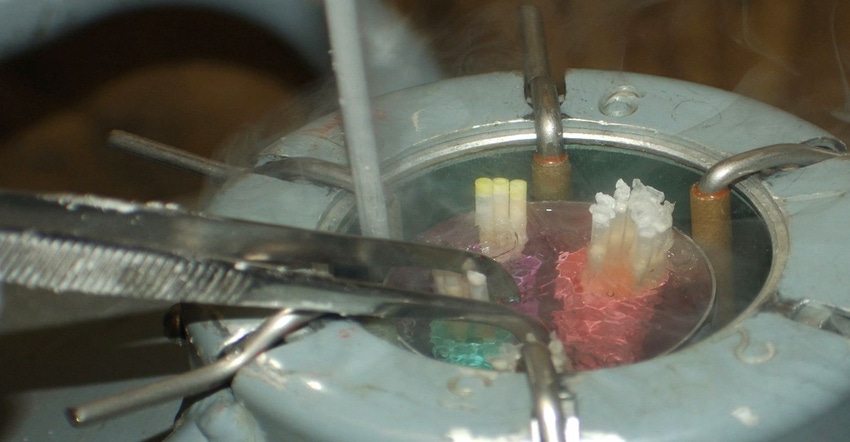A successful AI program depends on understanding what protocol you are using and following it exactly as it is recommended.
May 6, 2022

Some spring calving herds are starting to gear up for the breeding season by utilizing either natural service, artificial insemination (AI), or a combination of both. According to a recent NAHMS survey, 84.85% of operations utilize natural service only and 10.3% utilizing AI and exposure to bulls. The implementation of estrous synchronization has the potential to shorten your calving window, concentrates labor, allows for more uniform management of cows, and can create a more uniform calf crop. Artificial insemination allows producers to advance the genetic merit of their herd, reduces the number of bulls used during the breeding season, can increase weaning weights, and when combined with estrous synchronization it can shorten the calving season.
Preparing cows for the breeding season
There are a few things we need to be thinking about to prepare our cows for the breeding season and to have successful AI rates. These management options would include cows being in a positive plane of nutrition, a good yearlong mineral program to meet any deficiencies , cows in 5 to 6 body condition score, and inventory your supplies. Furthermore, we recommend having conversations with your veterinarian to ensure you have appropriately timed your pre-breeding vaccination program (at least 30 days prior to breeding for successful conception) and it is also a good time to get any synchronization products you may need. Other things to consider are making sure your working facilities are in good working condition, have accurate records to identify females and record breeding information. In addition, a successful AI program depends on understanding what protocol you are using and following it exactly as it is recommended.
Keep in mind that moving to pasture or transporting cows should be done shortly after breeding (1 to 4 days post AI) or waiting after 35 days. This will help reduce the incidence of early fetal loss, since maternal recognition of pregnancy is established around day 16. When you are transporting or moving a large group of animals, make sure you keep stress, heat, and working stress to a minimum.
Selecting a synchronization and AI protocol
The goal of estrous synchronization is to bring cows into heat at the same time. If producers decide to use synchronization, understanding how different protocols can fit their operation, goals, and facilities will all be important to consider. Perhaps you are wanting to start with a smaller group of animals, synchronization of heifers before the cow herd can be an option to start implementing these reproductive technologies.
Not every producer may know how to AI, so identifying AI technicians or working directly with bull stud/AI companies to help with that process will be important to secure prior to breeding. What supplies do you need to have for AI? Proper equipment and facilities should be used to ensure the safety of the animals and technicians, this includes good working chute(s) and facilities such as a breeding barn, low stress animal handling, access to warm water, water bath to thaw semen, paper towels, OB sleeves, and a person to keep records of cows being bred.
Perhaps you would like to capitalize on having more calves born earlier in the calving season, but want to start simple and do not want to deal with the increase in labor, cost, and facilities to implement a multiple day synchronization and AI protocol? A simple, one shot, one time through the chute may be an option and then use bulls for natural service during the breeding season. Data from the University of Nebraska reported that heifers born during the first 20 days of the calving season compared to those born later were heavier at weaning, pre-breeding, and calving. This in turn, produced heifers that were more likely to be cycling by the start of the breeding season and more likely to get pregnant. The benefit of conceiving early results in heifers staying in the herd longer, thus increasing profitability.
For an effective breeding season to be successful with synchronization and AI, nutrition, estrous cycle control, female management, proper facilities, labor, and expertise will need to be considered.
Source: University of Nebraska-Lincoln, which is solely responsible for the information provided and is wholly owned by the source. Informa Business Media and all its subsidiaries are not responsible for any of the content contained in this information asset.
You May Also Like



